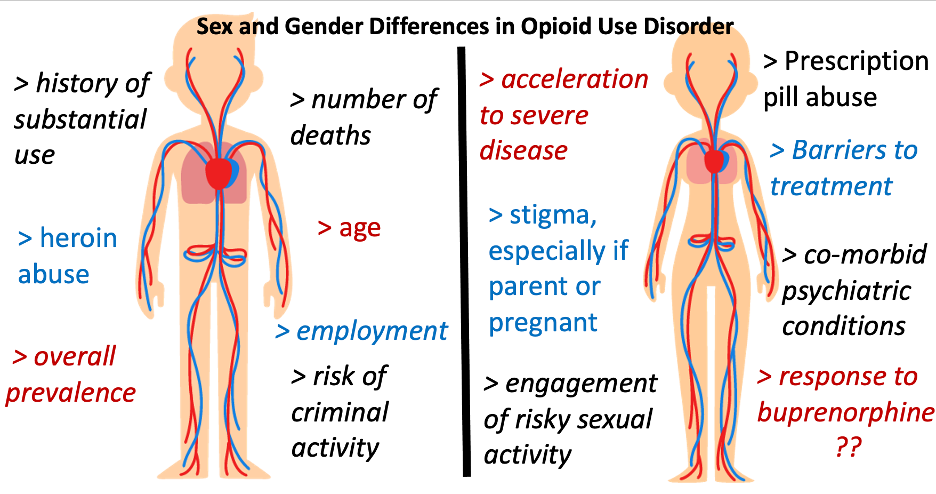Apr 8, 2022
Show Notes for Episode Twenty-One of seX & whY: Opioid Use Disorder
Host: Jeannette Wolfe
Guests:
Dr Alyson McGregor, author of Sex Matters: How Male-Centric
Medicine Endangers Women's Health and What We Can Do About It
Dr Lauren Walter
Here is link to American Psychiatric Association DSM 5 diagnosis for opioid use disorder from the CDC. Essentially the disorder is defined by continued craving and use of opioids despite significant social and professional consequences caused by its use.
This podcast is on sex and gender differences in opioid use disorder. Although sex (s) and gender (g) are rooted in different etiologies - biological sex via innate chromosomal and hormonal characteristics while gender is heavily influenced by sociocultural factors, they are often heavily interconnected. Experiences influence gene expression through epigenetics and if a man is exposed to different experiences than a woman, they can have different epigentic responses. Further complicating things, however, is that if a male and a female have the same experience, they can have a different pattern of gene expression because the process of epigenetics itself is influenced by innate sex. Currently, if researchers are even looking for s/g differences in their data, they are usually doing so at a very basic level like patient reported demographics, this makes further exploration as to whether discovered differences are rooted in innate physiology or cultural influences difficult. Essentially, appreciating the current limitations of research, we will use the term “men” and “women” in this blog.
To highlight how recent the trend in research has been to even consider the potential influence of sex and gender as relevant factors in pain. A 2007 study that looked at over 10 years of research published in the journal Pain, found that almost 80% of their studies included only male animals and less than 4% looked at sex differences.
Stats
CDC- Opioid deaths accounted for > 70% of all deaths from drug overdoses (totally overdose deaths 70,630)
2019 Kaiser Family Foundation data
Opioid Overdose Deaths
|
2019 total deaths |
Men |
Women |
|
49,860 |
34,635 |
15,225 |
2020 data https://www.cdc.gov/nchs/nvss/vsrr/drug-overdose-data.htm - total overdoses > 93,000 estimates that 69,710 from opioids.
For comparison 2020 mortality numbers for car crashes were 38,680

Sex and Gender Differences
Women
- more rapid acceleration from first use to addiction and treatment entry
- Greater medical and psychiatric co-morbidities
- Younger
- Greater barriers to accessing treatment including managing childcare, transportation, and drug use stigma
- Increased risk of engagement of high risk sexual activity (risk further increased for sexual minorities)
- Maybe more responsive to buprenorphine
Men
- Older
- History of more substantial use
- increased history of legal/criminal activity
Overall, in women compared to men, the prescription opioid abuse is decreasing more slowly while heroin use in increasing more quickly.
“From 1999 to 2010, overdose deaths increased 265% among men and 400% among women (CDC, 2018)”
Once in treatment have similar outcomes
Multidimensional approach - medical and psychosocial needs - these may be different for men and women
Sex and Gender gaps in the literature
- Many studies done before the explosion of the opioid epidemic
- Limited data on people who are not in residential treatments or clinical trials
- Many studies focus on methadone which has different treatment setting and clinical management
Socioeconomic differences between typical methadone vs buprenorphine users
- Buprenorphine users more likely to be white, healthier, younger and from higher socio-economic class
Increasing comprehensive services such as: housing, childcare and social support can help both men and women but what type of services they need and utilization of services may be sex/gender specific
- Women tend to engage more in comprehensive services (may reflect greater psychosocial burden) and offering sessions with childcare or mother’s support group may help with follow through and improve outcomes
- Stigma against women who are pregnant and/or mothers may also impair ability to access treatments
May increase women’s participation by adding women support group and childcare services
Take Home Points
There are sex and gender physiological and sociocultural factors that come into play in substance use disorder
- Statistically men are more likely to have an issue with opioid use disorder however those numbers are narrowing
- Physiologically- females appear to be at greater risk for telescoping- in that they appear to be at greater risk for rapid acceleration in substance use an physiological dependence, they also may be more prone to side effects surrounding withdrawal such as nausea
- How people spiral into abuse may also be heavily influenced by sex/gender related factors as men often get hooked due to increased use in social situations, while women often are using alone and self-medicating for depression and anxiety. How they pay for their drug use is also gender influenced with men often resorting to stealing or criminal activity and women to sex trafficking
- Over the last few years there has been a cultural shift as to how to best manage patients with substance use disorder with a greater focus on harm reduction versus complete abstinence with the understanding supported by data, that harm reduction can dramatically decrease the morbidity and mortality associated with substance use disorder and improve the health of local communities.
- Due to the opioid epidemic, there has been multiple initiatives to better identify and treat patients with substance use disorder including state wide prescription monitoring program, systemwide policies and electronic medical record prompted physician guideline for prescribing, and ED administered counseling, medical assisted therapies and harm reduction kits
Finally, we talked about Alyson’s important work with the Sex and Gender Summit which is geared towards integrating sex and gender-based principles across health care curricula to better educate future providers.
Here are two great resources to learn more on how to do searches to include sex and gender: